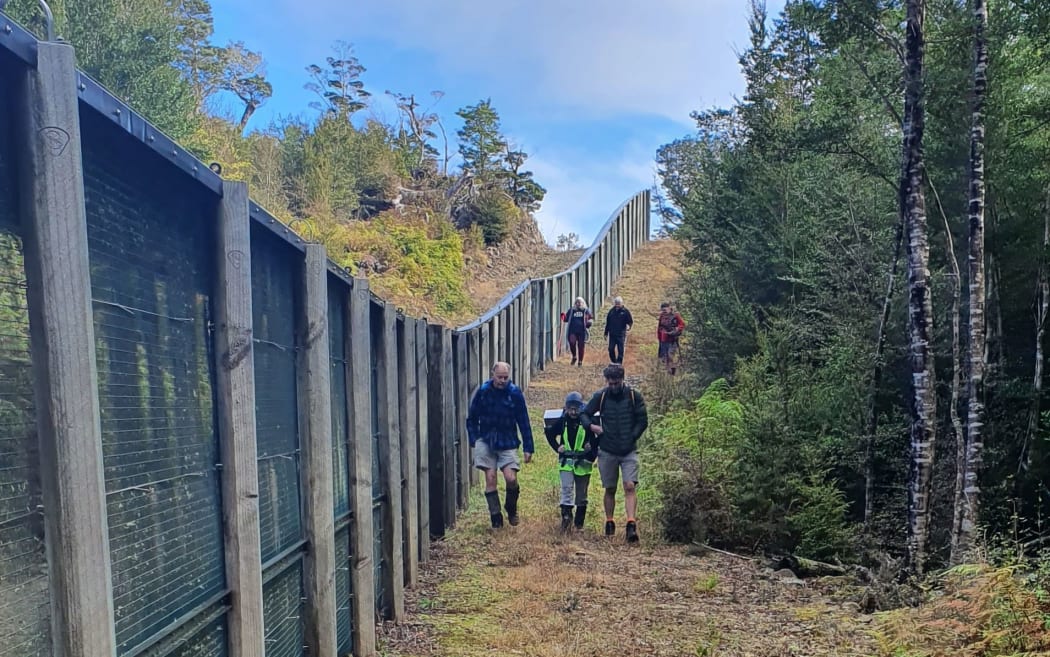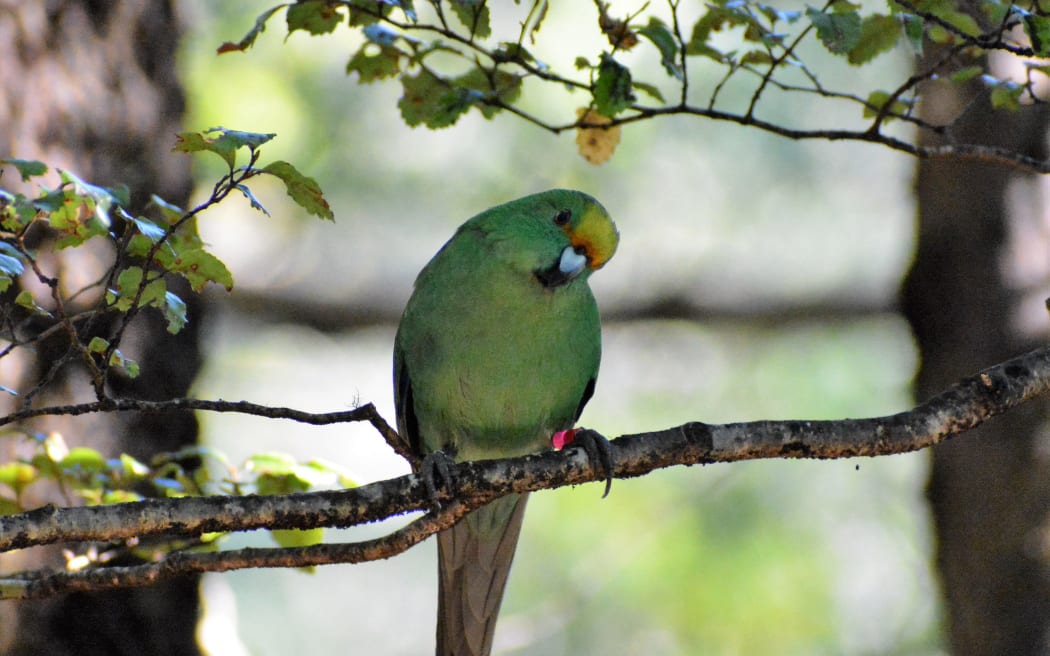Giant carnivorous land snails. New Zealand’s rarest parakeets. And noisy tieke or South Island saddlebacks.
All three species are at risk from introduced predators – and all have recently been given a safe new home on the outskirts of Nelson, inside the Brook Waimārama fenced sanctuary.
The 690-hectare forested valley was once the water supply catchment for Nelson. These days it satisfies a different kind of thirst – for nature and community conservation.

Brook Waimarama Sanctuary pest-proof fence. Photo: Alison Ballance
Follow Our Changing World on Apple Podcasts, Spotify, Stitcher, iHeartRADIO, Google Podcasts, RadioPublic or wherever you listen to your podcasts.
The Brook Waimārama sanctuary is surrounded by a 14.4 kilometre-long pest-proof fence that was constructed in 2016. In 2017, all introduced animals within the fence were removed; this included predators such as rats, stoats, possums and pigs, and browsing mammals such as goats and deer. In 2019 the sanctuary was declared pest-free. Mice have subsequently reinvaded, as they have in other fenced sanctuaries, and are a constant presence.
Occasionally, rats and weasels have managed to get back in but sanctuary staff and volunteers respond quickly, setting up networks of kill traps to catch the invaders.
Giant carnivorous land snails
In July 2022, 30 large land snails were released in the sanctuary.
The Powelliphanta hochstetteri consobrina snails were collected from two sites nearby, one a pine forest and the other native forest. Ten more snails from another site will be translocated later.
This is the first official translocation of a Powelliphanta species, and is possible because the subspecies is absent from the sanctuary but is clearly within its natural range.
This subspecies grows to about 5 centimetres across, and like all Powelliphanta snails is slow-growing and long-lived.
Powelliphanta snails hunt earthworms, which they slurp like spaghetti.
The snails will be left undisturbed for five years, when a search will be carried out to see if any small snails can be found, which will indicate that breeding has taken place.

Powelliphanta hochstetteri consobrina snails being released in the Brook Waimarama Sanctuary Photo: Alison Ballance
Orange-fronted parakeets / kākāriki karaka
Orange-fronted parakeets or kākāriki karaka are New Zealand’s rarest parakeet, with just a few hundred birds in the wild in North Canterbury.
In conjunction with the Department of Conservation, the Isaac Conservation and Wildlife Trust runs a captive breeding programme for kākāriki karaka. Starting in November 2021, there were five releases, each of 20 captive-reared birds, into the Brook Waimārama sanctuary.
They were released into tall beech forest at the top of the sanctuary, and almost immediately the birds paired up and began breeding. Some pairs produced two clutches of fledglings during their first summer in the sanctuary.

Neroli Amyes checking a kakariki karaka feeding station Photo: Alison Ballance
A small team of keen volunteers, including Sean McGrath, Neroli Amyes and Kevin Bolitho, visit the kākāriki karaka release site once or twice a week, to observe the birds, record their nesting behaviour and top up supplementary feeders with sunflower seeds.
As numbers build up, it is hoped that they will spread throughout the sanctuary, giving visitors a chance to see and hear one of New Zealand’s most colourful birds as it makes a comeback.

Male kakariki karaka Photo: Sean McGrath
There are plans underway for future reintroductions to the sanctuary, such as kākā, kiwi and tuatara, to help restore the ecosystem and bring nature back to Nelson.
Listen to the full story, as Alison Ballance joins the snail release, and meets some of the passionate volunteers working to keep predators out of the sanctuary and to help the reintroduced species thrive.
To learn more: New Zealand’s fenced sanctuaries
There are a number of private and public fenced sanctuaries in New Zealand. There are several episodes of Our Changing World featuring some of the best well known.
- Zealandia - Te Māra a Tāne, is a former water catchment reserve in central Wellington. It was New Zealand’s first fenced sanctuary, and the first fenced urban sanctuary in the world. An 8.6 km fence encloses 225 hectares of regenerating forest. There are a number of Our Changing World stories featuring Zealandia.
- Orokonui Ecosanctuary - Te Korowai o Mihiwaka is on the outskirts of Dunedin. Its 307 hectares of forest are protected by a 9 km pest-proof fence. One of the species they have returned to the area is the South Island kākā, but it hasn’t all be smooth sailing, as Claire Concannon found out in 2021.
- Sanctuary Mountain Maungatautari, in the Waikato is the largest sanctuary in New Zealand. It is 3400 hectares with a 47 km long pest-proof fence - a large mountain covered in intact conifer/broadleaf/podocarp forest, surrounded by farmland. Alison Ballance visited in 2011.
- Brook Waimārama Sanctuary is on the edge of Nelson. It is the largest sanctuary in the South Island, 690 hectares with a 14.4 km pest-proof fence. A former Nelson water supply reserve, the sanctuary is steep beech forest that is surrounded on three sides by the Richmond Forest Park and on the other by Nelson city. The idea of the sanctuary was first suggested in 2002.


